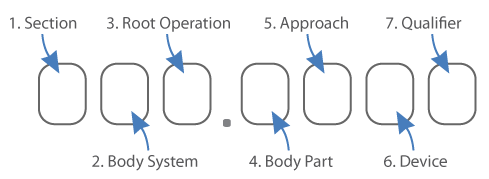ICD-10 PCS (Procedure) Codes |
Back to ICD-10 Home |
The International Classification of Diseases, Tenth Edition (ICD-10) is a clinical cataloging system that went into effect for the U.S. healthcare industry on Oct. 1, 2015, after a series of lengthy delays. Accounting for modern advances in clinical treatment and medical devices, ICD-10 codes offer many more classification options compared to those found in predecessor ICD-9.
ICD-10 Procedure Coding System (ICD-10-PCS) is a system of medical classification used for procedural codes that track various health interventions taken by medical professionals. ICD-10-PCS is a completely separate medical coding system from ICD-10-CM, containing an additional 87,000 codes for use ONLY in United States inpatient, hospital settings. Common procedures, lab tests, and educational sessions that are not unique to the inpatient, hospital setting have been omitted from ICD-10-PCS. ICD-10-PCS codes must be used on all HIPAA transactions, starting in October 2013.
ICD-10 PCS (Procedure)

The system uses three to seven digit alphanumeric codes to specify medical procedures. Each character can be any of 34 possible values the ten digits 0-9 and the 24 letters; the letters “O” and “I” are excluded to avoid confusion with the numbers “0” and “1”. The first digit indicates the section of medical practice (surgery, administration, measuring and monitoring, etc.) and the following digits specify the body system , root operation, body part, approach and the device used. The seventh character is a qualifying digit. No decimal is used.
GEM (General Equivalence Mapping)
General Equivalence Mapping (GEM) refers to the mapping tools designed and used to perform an ICD-9 to ICD-10 crosswalk.
The conversion will not always result in simple one-to-one mapping. While some ICD-9 codes do map directly to an ICD-10 code, it does not always mean the codes match in detail. Many codes will require additional information in order to correctly map the intended ICD-10 code; information such as, cause, location, type of encounter, etc. Some ICD-diagnosis codes, like those pregnancy and obstetrics, will garner a one-to-three crosswalk, depending on the stage and complication of pregnancy. In extreme cases, like the coding of fractures and disorders of the bone and cartilage, the ICD-9 to ICD-10 crosswalk can result in ICD-10 mapping that yields hundreds to thousands of results. For a period of two years or more, systems will need to access both ICD-9-CM codes and ICD-10-CM codes as the country transitions from ICD-9-CM to ICD-10-CM. Mapping will be necessary so that equivalent codes can be found for issues of disease tracking, medical necessity edits and outcomes studies.